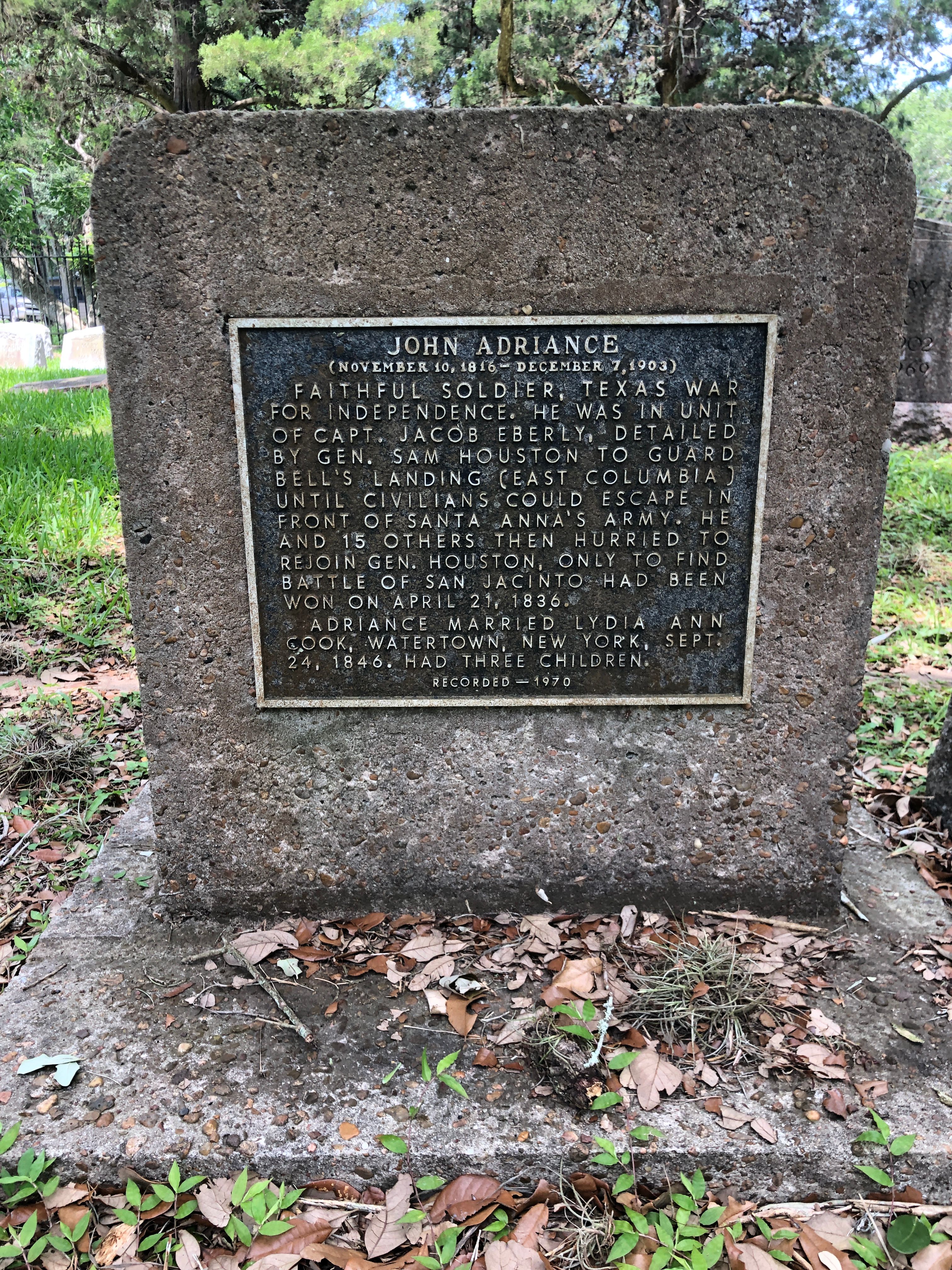![]()
By Tracy Gupton
When John Adriance was laid to rest at Old Columbia Cemetery in December of 1903 he had left his mark on the East and West Columbia communities. He had been a soldier in Texas’s fight for independence from Mexico, a local merchant and legislator in the early days of Texas.
A brief biography of John Adriance on the Texas State Historical Association website reveals that the native of New York first stepped foot on Texas soil in 1835. He was born in Troy, New York, either in 1816 or 1818, the son of George Cornelius Adriance and Gertrude Adriance. The TSHA piece lists Adriance’s birth year as 1818 but his headstone at Columbia Cemetery has 1816 etched into it.
His date of birth is listed as November 10, 1816, on a state historical marker near his grave at Columbia Cemetery. It reads: “Faithful soldier, Texas war for independence. He was in unit of Captain Jacob Eberly, detailed by General Sam Houston to guard Bell’s Landing (East Columbia) until civilians could escape in front of Santa Anna’s Army. He and 15 others then hurried to rejoin General Houston, only to find Battle of San Jacinto had been won on April 21, 1836.”

Columbia merchant, soldier John Adriance
The historical marker at Columbia Cemetery closes with information about Adriance’s marriage to Lydia Ann Cook on September 24, 1846. The marker, which was dedicated in 1970, says that John and Lydia Adriance had three children but the TSHA biography on Adriance states that he and Lydia had three daughters and one son. It says that Lydia Adriance died in 1871 and, after her death, John married his sister-in-law, Catherine Nash. A headstone located near the graves of John and Lydia Adriance at the West Columbia historical cemetery is that of their daughter, Sarah B. Adriance, who was born in 1850 and died 60 years later in 1910. Sarah’s father, John Adriance, died in Columbia on December 7, 1903.
A newspaper clipping published at the time of Adriance’s passing reads: “John B. Adriance died at Columbia at the age of 88. He was one of the Texas pioneer citizens and assisted in her struggle for freedom. After the war of independence Mr. Adriance settled near Columbia and for years has been a prominent stockman and planter of Brazoria County. He was a Mason of high degree and for the last 50 years has never missed being present at the annual conclaves.”
Longtime West Columbia Mason Scott Leopold wrote in his 2012 book, “St. John’s Lodge No. 5: Masons in the Early Days of Texas,” that John Adriance was Worshipful Master of the local Masonic lodge in 1856 and 1857, then served in that leadership role again in 1861 and 1862. Leopold said that Adriance had worked for a New York firm developing land and producing cotton in Brazoria County.
The TSHA story about Adriance says that he received his early training in merchandising in New York City stores. After arriving in October 1835 at Bell’s Landing on the Brazos River in what today is known as East Columbia, Adriance became a partner with a man named Beardslee in a mercantile business at Columbia from 1836 to 1839. By 1840 Adriance had gone into the cotton marketing field with Morgan L. Smith in Columbia. Together the partners purchased the Waldeck Plantation and marketed cotton in New York, New Orleans and England. By 1847, Adriance and Smith had dissolved their business partnership and John Adriance continued alone in his mercantile business until the end of the Civil War.

State Historical Marker honoring Columbia resident John Adriance was erected at Columbia Cemetery in 1970
As talk of secession was being discussed across the South, John Adriance was named a member of the Brazoria County Committee of Correspondence on November 17, 1860. During the War Between the States Adriance acted as a deputy for the commissary department of the Confederacy at Columbia. The great wealth he had accumulated as co-owner of the Waldeck Plantation deteriorated during and after the Civil War.
Leopold wrote in his book on local Masons that John Adriance guarded Mexico’s President Antonio López de Santa Anna and his officers on their way to imprisonment at Velasco after they were taken prisoners at the Battle of San Jacinto. Other Texians acting as guards along with Adriance were Judge George B. McKinstry, Alexander W. Russell and Walter C. White, according to Leopold.
It is also noted in Scott Leopold’s book that John Adriance was a member of the 13th Texas Legislature and played a part in founding Texas A&M University, Prairie View A&M University and the University of Texas.
During the Civil War John Adriance was sworn in as a member of the Columbia Blues in the Confederate Army, according to Leopold who also wrote that Adriance had been a member of the Columbia Minute Men during the Mexican war of 1844. Along with his participation in the Texas Revolution shortly after John Adriance arrived in Bell’s Landing, he had taken part in three wars during the first 30 years he lived in Brazoria County.
Former West Columbia High School teacher and historian James Creighton wrote in his 1975 book, “A Narrative History of Brazoria County,” that the Columbia Blues numbered 101 men. Creighton said these Confederate Army recruits “were sworn in on October 5, 1861, at the warehouse of John Adriance.” He is listed as private “Jack” Adriance in the muster roll of Columbia Blues soldiers in Creighton’s book on Brazoria County history.
After the war he and his son operated a real estate firm. Adriance contributed to the Houston Tap and Brazoria Railroad and its extension to Wharton. For three years he headed the Immigration Department of the International-Great Northern Railway in Palestine, Texas.

Photo by Tracy Gupton
John Adriance descendant Bill Adriance, left, of Columbia Lakes, received his Sons of the Republic of Texas pin from Bill Yates earlier this week at a meeting of the group at the Stephen F. Austin-Munson County Park near Angleton.
When he was in his early 80s, John Adriance gave a reporter a description of Columbia as it had appeared in his memory from 1836 when he was a young man. “He said (the first capitol building) had been the first house of representatives of the republic,” reporter Richard Spillane wrote from an interview with Adriance in January 1898. “There was a somewhat larger building to the South of it which was the senate chamber, but it was torn down years ago.”
“The two buildings were originally put up for use as a store,” Adriance recalled as he was interviewed at a time when the first capitol building in West Columbia was in ruins. “The one that became the senate chamber was occupied by White & Knight, who came to Texas in 1826. The house of representatives was occupied by a merchant called Kelsey. There were a great many log buildings near by which were used by the different departments of the republic for offices.”
Creighton wrote that Columbia remained the capitol of the Republic of Texas from 1836 until “final transfer of the capital was not affected, however, until April 27, 1837, when the government arrived in Houston. There the officials found themselves in a worse situation than at Columbia, with overcrowding, lack of buildings, lack of supplies, and with mosquitoes large as grasshoppers.”
